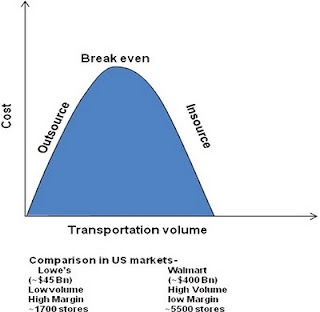Demand – Purchase Order – Receipt
Demand – Purchase Order – Receipt is a typical process of information flow from retail stores to the vendors and back from there. Apart from these, most of the full fledged retail lead organizations may include standard practices which may become more complex down the line. But in general, most of the organizations follow the following flow –
1. Regular Replenishment Orders (for all types of stock items at the retail stores) are created through automated systems which take care of demand planning. Most of the old retailers have the customized complex algorithms to take care of this. While with evolving technologies, packages such as JDA, Oracle and SAP have lot of inbuilt complex algorithms which the lead organizations can customize according to the different parameters required by the retailer.
2. Most of the times, these replenishment orders are generated on the basis of forecasted demand. Accordingly, the purchase orders are created against the vendor. Forecasted demand may be later on accompanied by the actual demand. Most of the times, these actual demands will never raise any orders against the vendors. This also depends upon the replenishment strategy (pull, push or hybrid) in which the lead organizations operate. Most of the big and old retail organizations with a bigger territory presence operate through hybrid replenishment strategy which brings profits to the lead organizations through economies of scale and stronger inventory management through regular replenishment and less lead time. Pull strategy is used when the demand uncertainty is very high and push strategy is used when demand uncertainty is very low.
3. It is also important to compare forecasted and actual demand. This helps the retailer to fine tune the parameters which are responsible for creating/ generating this demand on a timely manner.
Note: The information flow of a customer order (self initiated - generated from internet node OR sales associate initiates for the customer from store node) will be different from the replenishment order which is explained in the item #1 and #2.
Note: The PO of one entity in a SCM may act as a demand for its supplier but the behavior of the demand pattern may vary among all these entities.
4. When the vendors get these purchase orders, they try to find delivery locations, how much time they are going to take to prepare these orders and how much time do they take to deliver it to the lead organizations. These vendors may manage these deliveries by their own or may take help of some other third parties which are also called as consolidators. These consolidators are responsible for consolidating deliveries from various vendors. Consolidators are also called as carry forward agents (CNF agents or freight forwarders). In most of the cases, these are involved when the delivery locations are outside the country (exports).
5. Vendors may send the goods/ inventory through internal or outsourced transportation (may involve CNF agents/ freight forwarders). Vendors may send the advanced shipment notice (ASN) through EDI-856 (ASN, ASN-order, Order-item, item-label details) way before the goods are physically shipped (information is sent before the inventory). Through this, the lead organizations (retailer) get enough time to plan and manage the receiving of inventories at the warehouses. ASN information may be associated with EDI-810 (vendor invoice/ billing), EDI-315 (deliveries through ocean, mostly exports), EDI-214 (OTR-on the road shipment related information).
6. Actual demands will be sent to the warehouse locations along with the ASN information which will be used as an input to the lead organizations to manage the inventory better at the warehouse and retail outlets. This actual demand can be used during cross docking process at the warehouses. The orders which will have matching forecasted and actual demands, are the best candidates for 100% cross docking while which do not match are considered for partial cross docking (the rest of the inventory is received inside the warehouses and stored in warehouse locations).
7. These warehouse locations will be responsible for delivering these inventories to the retail outlets on a regular basis through cross docking and regular store replenishment to the retail outlets. These warehouse locations are located centrally, distributed or may be shared (with other lead organizations/ sellers). Shared warehouses are always third party warehouse experts which manage more than one client and these shared warehouses are only used depending upon the nature of business/ products with which the retailer is running business.
8. Orders are received at the retail outlets and accordingly inventory is incremented. The systems implemented at the retail outlet are reflected immediately at the local servers while they are updated periodically and frequently at the central servers.
9. Customer orders are raised through internet, telephonic call or by a sales associate at the retail outlet. These are for those items/ products which retailers do not keep stored in retail outlets and have less frequency of sale (less velocity of product) than any other stock products. Hence these are considered to be special orders. Customer orders can be fulfilled from the internet fulfillment centers/ warehouses/ vendors. These types of orders may also involve an extra price to the customers for the delivery. The delivery location and delivery options would be preferred by the customer.


Comments
Post a Comment